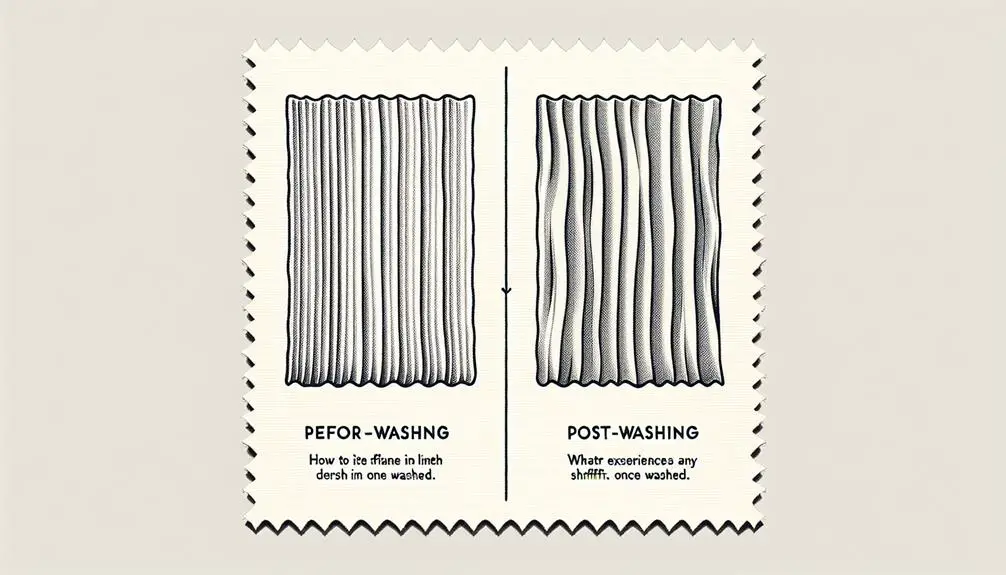Did you know that linen can shrink in both length and width, typically by about 4% but up to 10%, especially during the first wash cycle? It's fascinating how this natural fabric reacts to different conditions.
But what factors contribute to this shrinkage, and is there a way to control it? Understanding how linen behaves can help us make informed choices when caring for our linen garments.
Let's explore the nuances of linen shrinkage and how we can maintain our favorite linen pieces for longer wear.
Table of Contents
Key Takeaways
- Linen tends to shrink more in length than in width after washing.
- Lengthwise shrinkage can reach up to 4%, while widthwise is around 2-3%.
- Understanding linen properties helps in managing and maintaining original size and shape.
- Proper care during washing and drying is crucial to prevent significant linen shrinkage.
Factors Influencing Linen Shrinkage
When it comes to understanding why linen shrinks, several key factors play a crucial role in influencing this phenomenon. Linen, a natural fabric made from flax fibers, tends to shrink more in length than in width after the first wash, with an average shrinkage of about 4%. This shrinkage in length is more noticeable due to the alignment of these fibers in the fabric.
The extent of shrinkage in both length and width can be influenced by factors such as water temperature, agitation during washing, and drying methods. To minimize shrinkage, it's essential to follow proper care instructions, including washing linen items at recommended temperatures and opting for gentle drying methods like air drying. By understanding the properties of linen and adhering to care guidelines, one can help maintain the original size and shape of linen products for longer periods.
Shrinkage Tendencies in Length Vs. Width
After understanding the factors influencing linen shrinkage, it becomes evident that linen typically exhibits more pronounced shrinkage in length compared to width, with the fabric contracting up to 4% longitudinally and around 2-3% laterally after washing. This differential shrinkage between length and width is a common characteristic of linen due to the nature of its natural fibers.
The tight weave of linen fibers can lead to significant shrinkage in length as the fibers constrict during the washing process, causing the fabric to shorten. On the other hand, width shrinkage, although less noticeable, can still impact the overall size of linen clothing or other items.
Being aware of these shrinkage tendencies in length versus width is crucial for managing the size of linen products. By understanding how linen fabric behaves during washing, one can better predict and accommodate for any size changes that may occur, ensuring that the final product fits as desired.
Washing and Drying Effects on Linen
In caring for linen, the effects of washing and drying play a crucial role in maintaining the fabric's original dimensions and quality. When it comes to washing linen, using lukewarm water is essential to prevent excessive shrinkage in both length and width. Additionally, opting to air dry linen instead of using a dryer can help preserve its dimensions more effectively. Proper care during the washing and drying processes is paramount for ensuring that linen retains its original shape and size.
Washing and Drying Effects on Linen:
- Use Lukewarm Water: Washing linen in lukewarm water can prevent shrinkage in both length and width.
- Air Dry Gently: Opt for air drying linen instead of using a dryer to maintain its original dimensions.
- Proper Care is Key: Ensuring proper care during washing and drying processes can help prevent linen from shrinking.
- Avoid High Temperatures: High temperatures from water, dryers, and irons can lead to significant shrinkage in linen fabric.
Tips to Prevent Linen Shrinkage
To maintain the original dimensions and quality of linen, it's crucial to implement effective measures that prevent shrinkage. When caring for linen, follow the care instructions diligently. Start by washing items in lukewarm water with gentle detergents, avoiding high temperatures that can trigger shrinkage.
After washing, opt for gentle drying methods to minimize excessive shrinkage; air drying is a suitable choice. If your linen has shrunk slightly, ironing it while damp can help reshape and stretch the fabric back to its original size.
Caring for Linen to Maintain Size
Maintaining the size of linen requires diligent care and attention to detail throughout the washing and drying process. When caring for linen items, it's essential to follow specific care instructions to minimize shrinkage. Here are some key points to consider:
- Use a washing machine: Opt for a gentle cycle and avoid hot water to prevent excessive shrinkage.
- Choose quality linen: Higher fabric quality can result in less shrinkage after washing.
- Utilize air drying: Line drying or flat drying can help maintain the size of linen items compared to using a dryer.
- Iron with care: Iron linen while damp and gently stretch the fabric to restore it to its original dimensions.
Frequently Asked Questions
Does Linen Shrink in Length?
Personally, linen can indeed shrink in length. Remember to read care labels, stick to gentle washing, and avoid high heat to curb this. Proper handling can preserve the fabric's dimensions and keep your linen looking fresh.
Should You Size up or Down in Linen?
When it comes to sizing in linen, consider potential shrinkage. Anticipate more shrinkage in length than width. To maintain the desired fit, sizing up slightly can be beneficial. Follow care instructions for minimal changes.
Does Linen Loosen With Wear?
Wearing linen tends to make it looser over time due to the natural fibers relaxing. The fabric may slightly stretch in areas with more movement. Following care instructions and handling it gently can help maintain its shape.
How Do You Reverse Linen Shrinkage?
To reverse linen shrinkage, I soak it in warm, soapy water and gently stretch it back to size. I hang it flat to dry, then press and stretch with a mild iron. Avoid harsh methods to prevent damage.
- Tetron Fabric for Marine Applications: Durability and Use Cases - June 18, 2025
- Tetron Fabric for Outdoor Furniture: Weather Resistance and Care - June 18, 2025
- Tetron Fabric for Wall Coverings: Style and Application Tips - June 18, 2025



